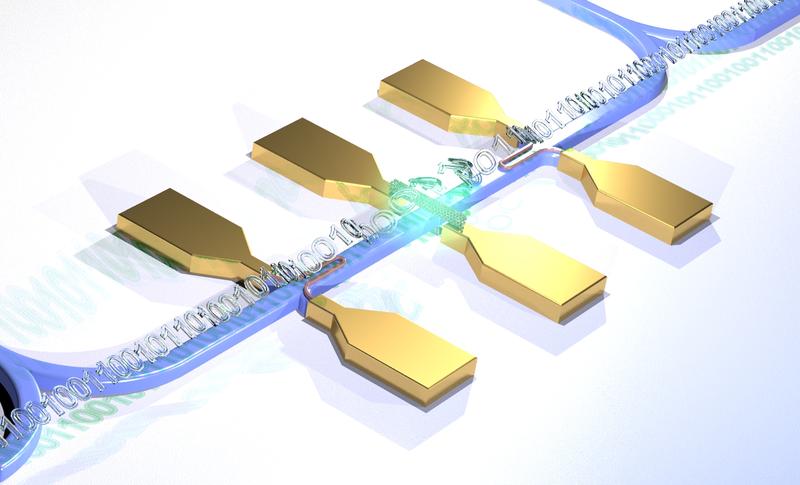

Graphic representation of part of a chip, showing with photon source, detector and waveguides
Illustration: Münster University/Wolfram Pernice
Optical quantum computers are what people are pinning their hopes on for tomorrow’s computer technology – whether for tap-proof data encryption, ultrafast calculations involving enormous quantities of data or so-called quantum simulation, which allows highly complex systems to be reproduced on the computer.
So far, experiments researching into the applicability of this technology have filled entire laboratory rooms. In order to use this technology in a meaningful way, however, it needs to be accommodated in a very small space. For the first time researchers have now succeeded in putting a complete quantum optical set-up on a chip. This meets one requirement for making it possible to use photonic circuits for quantum computers.
The results have been published in the current issue of the “Nature Photonics” journal (advance online publication). Those involved in the study included a team of scientists from Germany, Poland and Russia – headed by Professors Wolfram Pernice from Münster University and Manfred Kappes and Carsten Rockstuhl from the Karlsruhe Institute of Technology (KIT).
The light source which the researchers used for the first time for the quantum photonic circuit was special nanotubes made of carbon. These have a diameter which is a hundred thousand times smaller than a human hair and they emit single light particles (photons) when stimulated by means of laser light. These photons are also known as light quanta, which explains the term “quantum photonic”.
The fact that the carbon tubes emit single photons makes them attractive as an ultra-compact light source for optical quantum computers. “However, the laser technology can’t be put onto a scalable chip just like that,” says physicist Wolfram Pernice, sounding a cautionary note. The scalability of a system – in other words, the possibility of miniaturizing components in order to increase the quantity – is, however, the precondition for using the technology for high-performance computers, all the way up to optical quantum computers.
Because all the elements on the chip now developed are driven electrically, no additional laser systems are necessary any more – which is a considerable simplification compared with conventional optical stimulation. “The development of a scalable chip which combines single photon source, detector and waveguides is an important step for researchers,” says Ralph Krupke, who is himself engaged in research at the KIT’s Institute of Nanotechnology and at the Institute of Material Science at the Technical University of Darmstadt. “As we were able to demonstrate that single photons can also be emitted by electrical stimulation of the carbon nanotubes, it means that we have overcome a limiting factor that was until now a barrier to any applicability.”
Turning to the methodology: the scientists looked to see whether single photons were emitted when electricity flowed through carbon nanotubes. For this purpose they used carbon nanotubes as single photon sources, superconducting nanowires as detectors and nanophotonic waveguides. One single photon source and two detectors were each connected to one waveguide. The set-up was cooled using liquid helium in order to be able to count individual photons. The chips were produced with an electron beam plotter.
The work done by the scientists is basic research. It is not yet clear whether – and, if so, when – it can be put into practice. Wolfram Pernice and lead author Svetlana Khasminskaya received funding from the German Research Foundation and the Helmholtz Association, while Ralph Krupke received financial support from the Volkswagen Foundation.
Original publication:
Khasminskaya S. et al. (2016): Fully integrated quantum photonic circuit with an electrically driven light source. Nature Photonics; DOI 10.1038/nphoton.2016.178
Media contact at KIT:
Kosta Schinarakis
Phone: +49 721 608 41956
Mail: schinarakis@kit.edu
http://www.nature.com/nphoton/journal/vaop/ncurrent/full/nphoton.2016.178.html Original publication (“Nature Photonics”)












